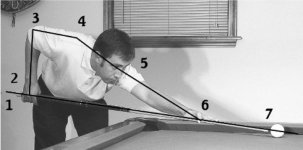Sam,
Is that not what Gene sort of went over with you...
where best to place the cue for You, the individual, to best see the straight line.
When I was very young & switching from ghost ball to equal & opposite fractional overlap...
my sight line was on the line that divided the fraction & the cue stick was parallel.
I was NOT looking down the cue stick line.
I still do this for the more thin cuts. It's sort of like looking edge to edge but with a fraction of overlap & the sight line that I am looking down is the dividing line of the fraction & it is parallel to the center line of the cue ball.
Somehow I do not think this is about what you were asking but your statement about diagram 4 being exactly for what you were looking has sort of confused me.
No big deal as long as you have the answer to your question.
Best 2 Ya,
Rick
It is indeed similar.
Dr. Dave's article has some complementary information that fits what I was looking for though.
